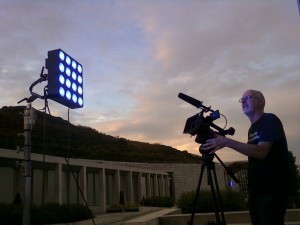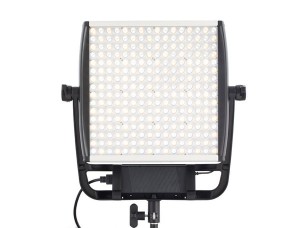Archive for the ‘Lighting’ Category
 Ruggedized LED lighting: A Welcome New Trend?
Ruggedized LED lighting: A Welcome New Trend?
Let’s hope so. Up to now, LED 1×1 arrays, even relatively pricy ones, have been constructed of cheap plastic or flimsy thin aluminum. This has posed a problem for many docco ENG type shooters who must increasingly shoot standup of a egotistical weatherman or news anchor fighting to stay upright amid the winds and driving rain of a category 5 hurricane.
Unlike previous fragilely constructed LEDs the new Lowel Prime Location bi-color LED is built like a Soviet tank. Constructed of heavy grade alloy with massive heat sinks, the fixture is all but impervious to bad weather, hurricanes, and blizzards. It is the first instrument of its kind to earn an IP65 rating, reflecting maximum resistance to damage from physical shock and water penetration, short, that is, of operating the unit underwater, which is not advised.
For non-fiction shooters the Lowel Prime Location is hopefully the harbinger of a new trend. The smoothness of an LED’s spectral output in the field is of course critical, especially with respect, say, to a reporter’s flesh tones, but any discussion of CRI and color fidelity is moot if the LED is incapable of withstanding the rigors of actual field use.

Lowel Prime Location LED
 LEDs Are the Future But Some Specialized LEDs Have Problems Now
LEDs Are the Future But Some Specialized LEDs Have Problems Now
The current trend to use LED lighting exclusively on feature films and high-end commercials has carried with it some interesting dichotomies. On the one hand the advent of LED instruments designed for cinema applications like the Litepanels remarkable new Astra 1×1 delivers a very bright flattering light with an exceptionally smooth color output. The RGB/RGBW LED fixtures on the other hand increasingly requested by DPs tend to be borrowed from live theater and stage. The use of such lighting for feature production introduces a bevy of potentially serious problems; the dimmed output as low as two percent in my latest project contributing to a pronounced flicker that can be most difficult to read and compensate for.
Shooting in Japan and Singapore in August and September I found myself capturing the movie’s behind-the-scenes featurette at 29.976FPS with various shutter settings of 216º, 225º, and 230º, the middle setting seeming to me especially illogical given the 50Hz operating environment. The syhchro shutter in professional cameras can of course accommodate virtually any setting no matter how weird; the real problem is addressing the other discharge lighting that may be present in a scene like the rear projection screens in my particular operating at 24FPS (actually 23.976FPS) that require a shutter of 230º, the neon, fluorescent, and even the studio house lights that require 216º, and the RGB LEDs that would strobe obnoxiously if not captured at 225º.
With new suitably designed flicker-free LED fixtures entering the market from Litepanels, Kino Flo, and others, one can finally see some hope at the end of the tunnel for keeping all of this. Once the same manufacturers introduce RGB fixtures with the same flicker free characteristics we as shooters will be finally able to escape the LED flicker menace once and for all.
After my experience over the last ten weeks I for one am eager to embrace a more orderly RGB LED shooting environment.

Shooting with RGB+blue LEDs is becoming increasingly common given the current trend. The potential introduction of annoying flicker is a threat that requires constant vigilance.

We need a wider range of flicker-free LED instruments like the new Litepanels Astra. Will the company introduce an RGB version? I hope so.